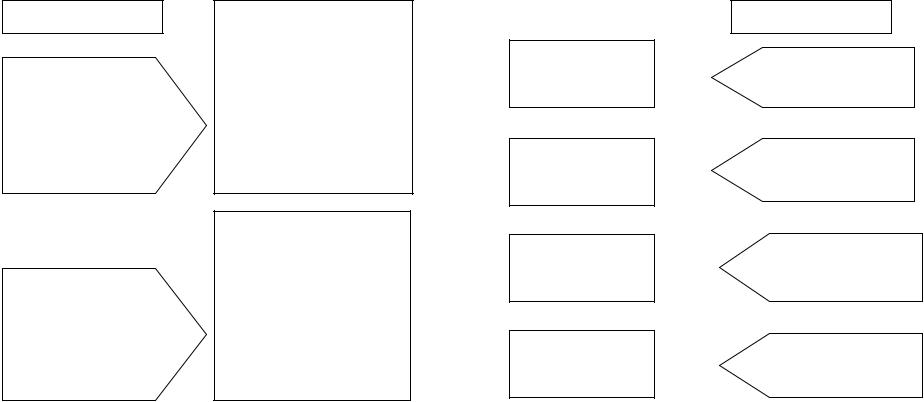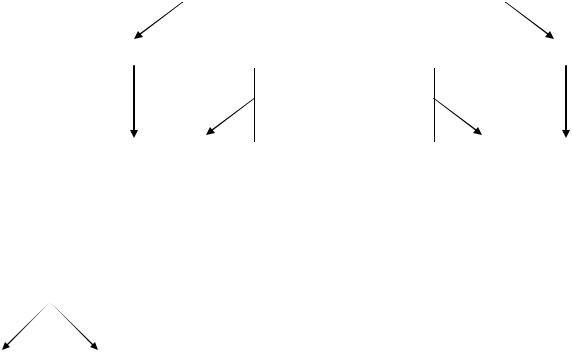
14-05-2015_19-15-42 / AНСМОВА_ПДРУЧНИК
.pdf
281
The cooperative principle of communication. The Gricean maxims
maxim of quality
BE TRUTHFUL
maxim of quantity
QUANTITY of
INFORMATION
maxim of relation
RELEVANCE
maxim of manner
BE CLEAR
Table 21 (to chapter 2.1.)

282
Components of Speech Activity
1. Motive or reason for speech activity
Learner's motive: |
|
Teacher's motive: |
Why should I listen to sb's |
|
How should I motivate students |
speech? |
|
to initiate communication or |
Why should I speak? |
|
receipt sb's message? |
Why should I read the text? |
|
|
Why should I write to sb? |
|
|
|
|
|
2. Subject of speech activity
is a thought, idea, message
4. Product of activity
In speaking – utterance; In writing – text;
In listening and reading – comprehension.
3. Means of realization phonetic, lexical, grammatical/structural
5. Result of activity may be expressed in the reaction – a reply (answer) of a person.
Table 22 (to chapter 2.1., 2.4)

283
The theory of activity
Five steps of activity procedure.
lead-in or pre-activity |
|
close the activity |
motivationally-oriented |
run the activity |
final step of activity |
|
activity itself |
|
set up the activity |
post activity |
first step of activity |
follow-up stage |
(According to Scrivener J. Learning Teaching. – Oxford: Macmillan Heinemann, 1994.–218p.)
Table 23 (to chapter 2.4.)

284
Characteristic of communicative activity
Communicative activity
Has |
|
Creates |
|
|
|
Involves |
|
Encourages |
|
A purpose that can |
|
A desire to |
|
Focuses on |
|
Students in using a |
|
To communicate |
|
be created by some |
|
communicate |
|
Content, |
|
variety of language |
|
without |
|
information or |
|
|
|
|
|
|
- |
teacher |
|
|
|
|
not form |
|
|
|
|||
opinion gap |
|
|
|
|
|
|
|
intervention |
|
|
|
|
|
|
|
|
|
||
|
|
|
|
|
|
|
|
- |
materials |
|
|
|
|
|
|
|
|
|
control |
|
|
|
|
|
|
|
|
|
|
|
|
|
|
|
|
|
|
|
|
Table 24 (to chapter 2.4.)
285
Classification of classroom activities
Controlled activities |
|
Semi-controlled activities |
|
Free activities |
|
|
|
|
|
Warm-up; |
|
Brainstorming; |
|
|
|
|
Role play; |
||
Setting; |
|
Story-telling; |
|
|
|
|
Games; |
||
Organisational; |
|
Question-answer, referential; |
|
|
|
|
Report; |
||
Content explanation; |
|
Cued narrative/Dialogue; |
|
|
|
|
Promlem solving; |
||
Role play demonstration; |
|
Information transfer; |
|
|
|
|
Drama; |
||
Dialogue/narrative presentation; |
|
Information exchange; |
|
|
|
|
Simulation; |
||
Dialogue/narrative reaction; |
|
Wrap-up; |
|
|
|
|
Discussion; |
||
Reading aloud; |
|
Preparation. |
|
|
|
|
Composition; |
||
Checking; |
|
|
|
|
|
|
|
Debate. |
|
Question-answer, display; |
|
|
|
|
|
|
|
|
|
Drill; |
|
|
|
|
Translation; |
|
|
|
|
Dictation; |
|
|
|
|
Copying; |
|
|
|
|
Identification; |
|
|
|
|
Recognition; |
|
|
|
|
Testing. |
|
|
|
|
|
|
|
|
|
|
|
|
|
|
(According to G. Crookes & C. Chaudron. Guidlines to Classroom Language Teaching// . – p.4
Table 25 (to chapter 2.4.)

286
Exercises in Language Teaching
Exercise Structure
I STAGE |
Task |
|
Every exercise has a task containing a reason for implementation of the appropriate speech action, situation or activity.
II STAGE |
Example |
||||
|
|
|
It is optional, exists only in case of |
||
|
|
|
|
||
|
|
||||
|
|
|
|
necessity. |
|
|
|
|
|
|
|
|
|
|
|
||
III STAGE |
Training/Practice |
|
|
It is exactly the exercise. |
|
|
|
||||
|
|
|
|
||
|
|
|
|
|
|
|
|
|
|
|
|
IV STAGE |
Assessment |
|
Teacher assessment
Peer assessment
Selfassessment
Table 26 (to chapter 3.1.)

287
Types of Exercises in FLT
Principal exercises |
|
Optional exercises |
|
|
|
Criteria
Direction of communication
Communication
value
Receptive
Reproductive Receptivereproductive Productive Receptiveproductive
Speech (communicative) Relativelycommunicative Language (Noncommunicative)
Oral/aural
Written
Monolingual
Bilingual
Practicing
Testing
Class
Home
Criteria
Fulfilment
format
Using L1
Function in teaching process
Place of exercising
(According to Методика навчання іноземних мов у середніх навчальних закладах: Підручник. - К.: Ленвіт, 1999.-C.66)
Table 27 (to chapter 3.1.)

288
|
|
Teaching Grammar |
||
|
|
|
|
|
|
Grammar minimum |
|
||
Active |
|
|
|
Passive |
|
|
|
||
|
|
|
|
|
|
|
Acquisition of |
||
|
|
grammar habits |
||
|
Reproductive habits |
|
|
|
Receptive habits |
||
|
Form |
|
|
|
Content |
||
|
Choosing |
|
Reception |
||||
|
|
|
|
|
|
||
|
|
|
|
|
|
||
|
Function |
Expressing |
|
Recognition |
Form |
||
|
|
|
|
|
|
||
Use |
Meaning |
|
|
|
|
Meaning |
|
|
|
|
Correlation |
||||
|
|
|
|
|
|
|
|
Table 28 (to chapter 3.2.)

289
Teaching active & passive grammar
Active grammar
Reproductive grammar habits
Choosing form to express necessary meaning in appropriate situations
Passive grammar
Receptive grammar habits
Recept some content recognizing
grammar form and correlate it with its meaning
Table 29 (to chapter 3.2.)
290
Presentation techniques of different grammar items
elicitation |
|
personalization – when |
|
presenting language in |
||||
a technique in which |
|
|
learners communicate |
|
|
context |
||
the teacher draws |
|
about themselves or their |
|
means encouraging |
||||
information from |
|
own lives. Personalize the |
|
students to hypothesize, to |
||||
learners through |
|
new grammar item means |
|
try the rules out, to seek |
||||
question and answer. |
|
|
to get learners using it, |
|
confirmation of their |
|||
|
|
|
|
talk about their lives, |
|
|
hypothesis. |
|
|
|
|
|
experiences, opinions, |
|
|
|
|
|
|
|
|
plans. |
|
|
|
|
|
|
|
|
|
|
|
|
|
|
|
|
|
|
|
|
|
|
|
using realia, |
|
|
direct explanation |
|
|||
|
pictures, |
|
|
|
|
|
|
|
|
time-line, etc. |
|
|
|
|
|
|
|
|
|
|
|
|
|
|
|
|
Table 30 (to chapter 3.2.)
